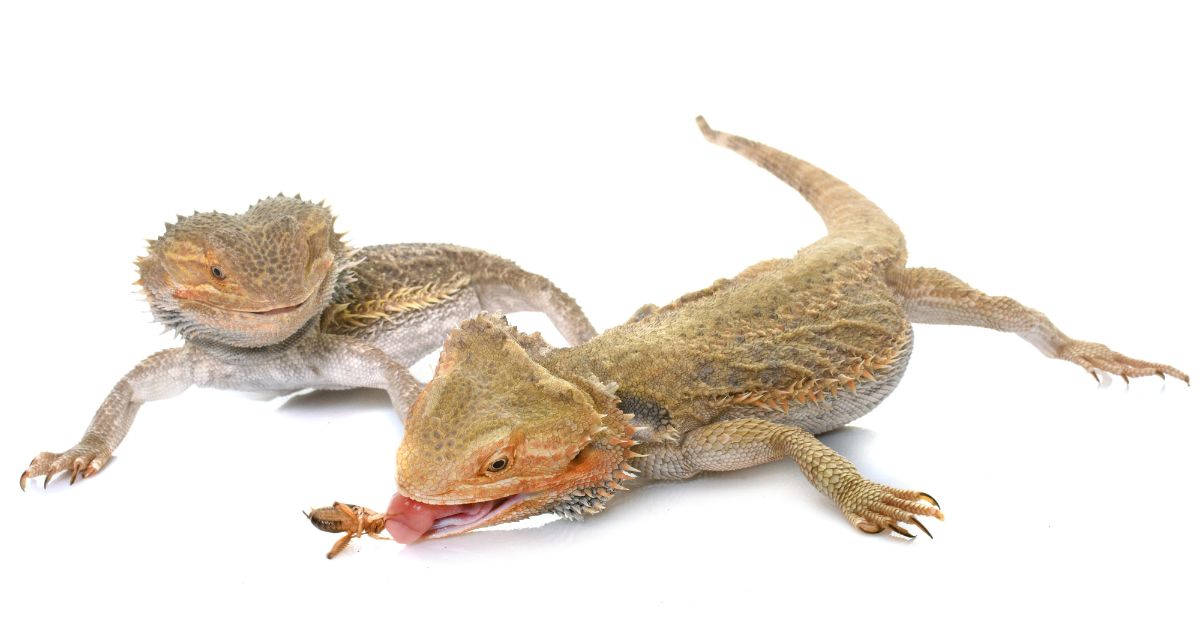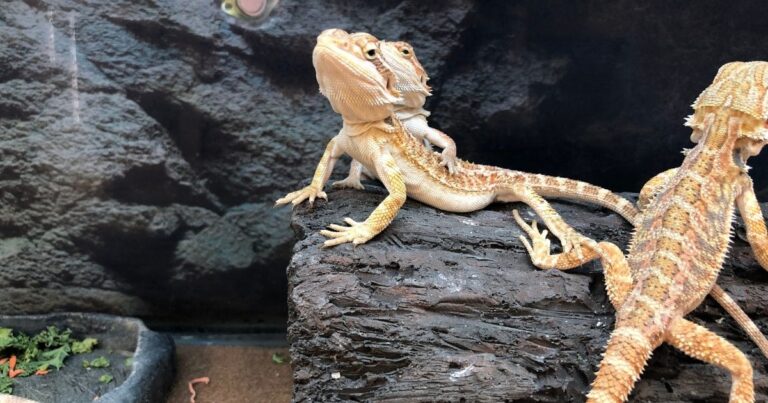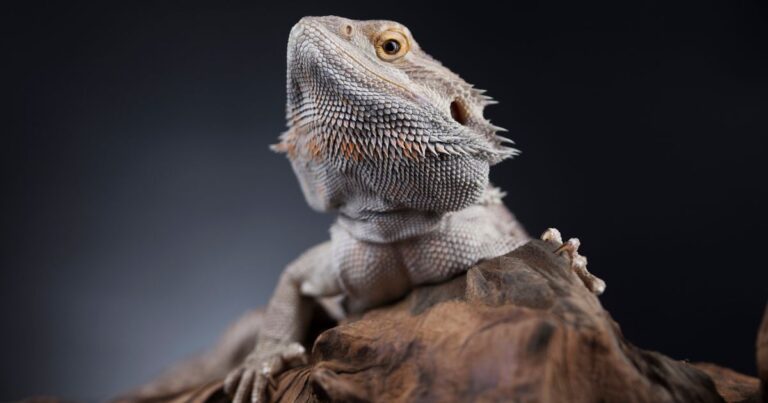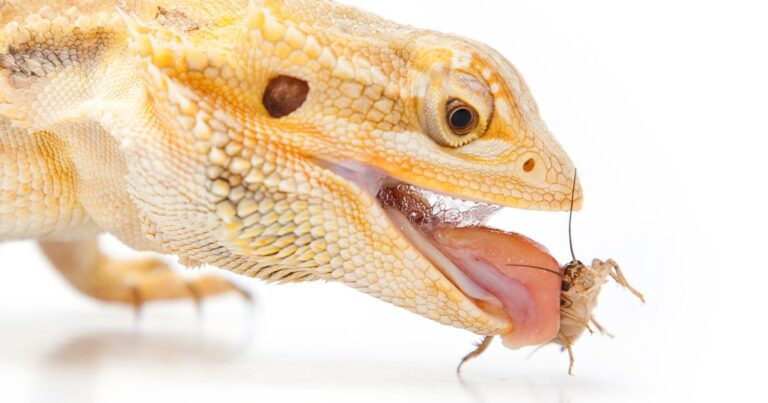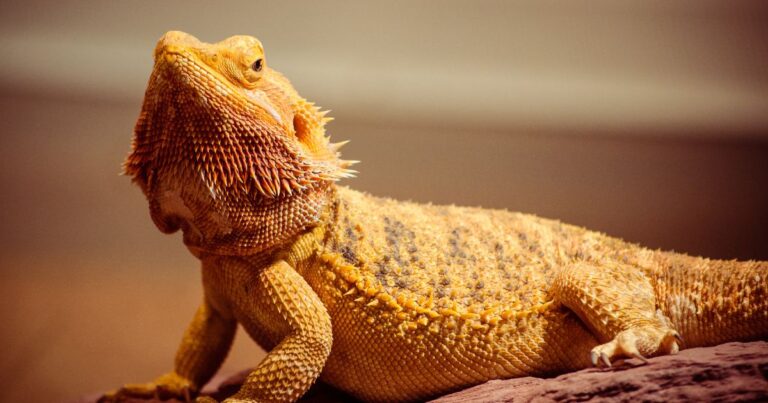Feeding frequency for bearded dragons
Table of Contents
Ever wondered how often to feed your bearded dragon? Well, buckle up, dragon lovers! In this article, we’ll dive into the exciting world of bearded dragon diets, exploring the feeding frequency for bearded dragons at different ages. Stay tuned for some scaly surprises!
Introduction
If you’re a proud owner of a bearded dragon or planning to get one, you might be wondering, ‘How often should I feed my bearded dragon?’ It’s a common question and one that’s crucial to the health and happiness of your scaly friend. Bearded dragons, like Gilbert, my own beloved pet, have specific dietary needs that change as they grow. Understanding these needs is the first step to ensuring your bearded dragon thrives.
Feeding your bearded dragon might seem complicated, but once you understand their dietary needs and how often they should be fed, it becomes a lot easier.
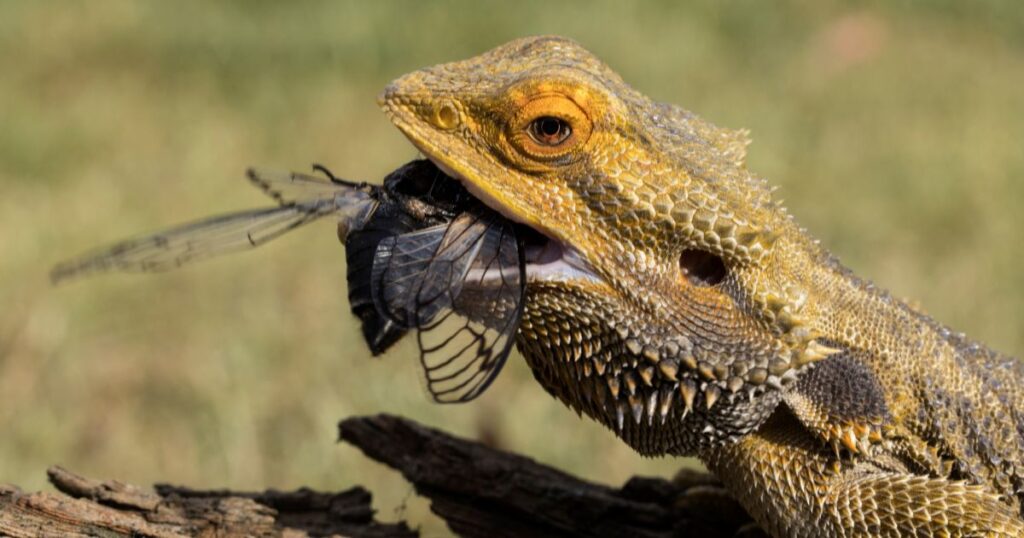
In this comprehensive guide, we’ll delve into the feeding frequency for bearded dragons, exploring how it varies with age and what a balanced diet looks like for these fascinating creatures. So, whether you’re a seasoned bearded dragon owner or a newbie, stick around as we embark on this informative journey. And remember, every bearded dragon is unique, so it’s always best to tailor their diet to their specific needs.
Understanding the Dietary Needs of Bearded Dragons
Top 5 Tips for Feeding Your Bearded Dragon
- Always provide fresh water
- Offer a variety of foods
- Feed appropriately sized insects
- Remove uneaten food
- Monitor your dragon’s weight and adjust diet as needed
Before we delve into the feeding frequency, it’s important to understand what a bearded dragon’s diet consists of. Bearded dragons are omnivores, which means they eat both plant-based foods and meat – in their case, insects. A balanced diet for a bearded dragon includes a mix of greens, vegetables, and feeder insects like crickets and mealworms.
However, the proportion of these food groups varies with the age of the bearded dragon. Younger dragons require more protein for their rapid growth, while adults need a diet rich in greens and vegetables. Understanding these dietary needs is crucial to providing your bearded dragon with the right nutrition. And remember, a well-fed dragon is a happy dragon!
Protein and Greens Ratio
| Age Group | Protein | Greens |
|---|---|---|
| Baby | 80% | 20% |
| Juvenile | 50% | 50% |
| Adult | 20% | 80% |
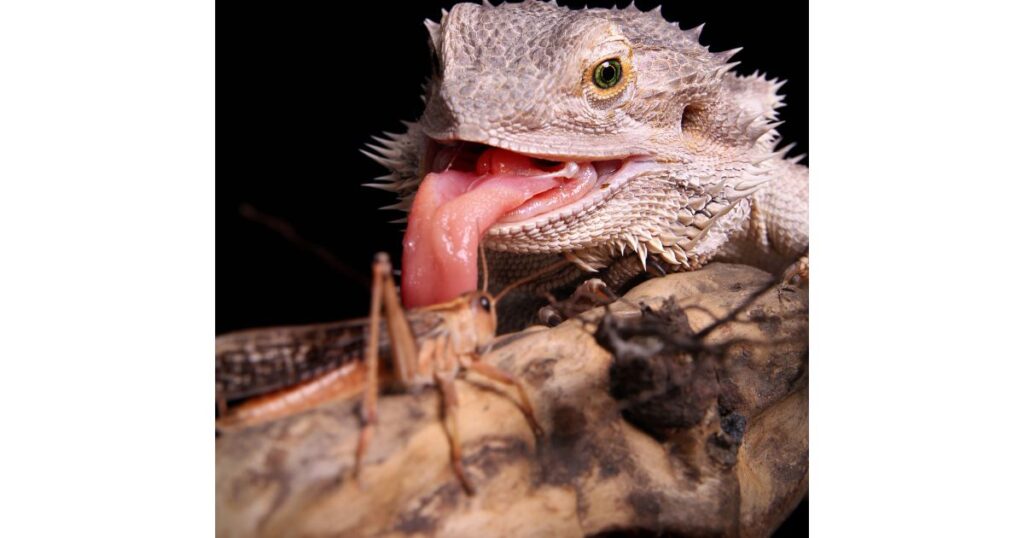
The Importance of Age in Determining Feeding Frequency
Did you know that the age of your bearded dragon plays a crucial role in determining their feeding frequency? It’s true! Younger bearded dragons, especially babies and juveniles, have a faster metabolism and are growing rapidly. As a result, they need to eat more frequently than their adult counterparts.
On the other hand, adult bearded dragons eat less frequently as their growth slows down and their metabolism stabilizes. It’s important to adjust the feeding frequency as your bearded dragon grows, ensuring they get the right amount of food at each stage of their life. So, let’s take a closer look at the feeding frequency for bearded dragons at different ages.
Feeding Frequency by Age
| Age Group | Feeding Frequency | Primary Diet |
|---|---|---|
| Baby | 2-3 times a day | Insects |
| Juvenile | 1-2 times a day | Insects & Greens |
| Adult | Greens daily, Insects 2-3 times a week | Greens & Vegetables |
Feeding Frequency for Bearded Dragons (Baby)
Baby bearded dragons are growing rapidly, and their diet needs to support this growth. They require a lot of protein, which means they need to eat a lot of insects. Baby bearded dragons should be fed multiple times a day – typically, they can eat two to three times a day, with each feeding consisting of as many insects as they can consume in a 10-15 minute period.
Remember, the insects should be appropriately sized for your baby dragon. A good rule of thumb is to never feed your dragon insects that are larger than the space between their eyes. This helps prevent choking and digestive issues. And don’t forget to supplement their diet with a variety of greens and vegetables, even though they might not eat much of them at this age.
When I first got Gilbert, he was just a baby. I was so excited to have him that I wanted to do everything right. I remember the first time I fed him – I was so nervous! I had read so many different things about feeding baby bearded dragons, and I wasn’t sure how often or how much to feed him. But as I watched Gilbert eat, I realized that he would let me know when he was full. He would eagerly chase after the crickets at first, but once he had his fill, he would simply stop and bask under his heat lamp. That’s when I understood that feeding a bearded dragon isn’t just about following a strict schedule, but also about observing and understanding their behavior.

Feeding Frequency for Bearded Dragons (Juvenile)
5 Foods to Avoid Feeding Your Bearded Dragon
- Avocado
- Rhubarb
- Lettuce
- Fireflies
- Raw meat
As your bearded dragon transitions from a baby to a juvenile, their feeding frequency will change. Juvenile bearded dragons, typically those between the ages of 3 months and a year, still need a diet high in protein. However, they don’t need to eat as frequently as babies.
Juvenile bearded dragons should be fed once or twice a day, again allowing them to eat as many appropriately sized insects as they can in a 10-15 minute period. At this stage, they should also start eating more greens and vegetables. Aim for a diet that’s about 50% insects and 50% plant-based foods to ensure they’re getting a balanced diet.
Feeding Frequency for Bearded Dragons (Adult)
Once your bearded dragon reaches adulthood, their diet and feeding frequency will need to be adjusted again. Adult bearded dragons, those over a year old, need a diet that’s primarily plant-based. They should be fed fresh greens and vegetables daily, with insects being offered only two to three times a week.
When feeding insects, allow your adult bearded dragon to eat as many as they can in a 10-15 minute period. This shift in diet reflects the natural eating habits of bearded dragons in the wild and helps prevent obesity and other health issues in captivity. Remember, a healthy bearded dragon is a happy bearded dragon!

Understanding the Role of Protein in a Bearded Dragon’s Diet
Protein is a vital part of a bearded dragon’s diet, especially when they are young. It supports their rapid growth and provides the energy they need to explore their environment. The primary source of protein for bearded dragons is insects, including crickets, mealworms, and other feeder insects.
However, not all insects are created equal. Some, like crickets and dubia roaches, are high in protein and make excellent staples in your bearded dragon’s diet. Others, like mealworms, are higher in fat and should be fed sparingly. Always research the nutritional content of the insects you’re feeding to ensure your bearded dragon is getting a balanced diet.
Common Feeder Insects
| Insect | Protein Content | Fat Content |
|---|---|---|
| Cricket | High | Low |
| Mealworm | Medium | High |
| Dubia Roach | High | Medium |
The Importance of Greens and Vegetables
While protein is important, greens and vegetables also play a crucial role in a bearded dragon’s diet. They provide essential vitamins and minerals that your dragon needs to stay healthy. Plus, they add variety to your dragon’s diet, which can help keep them interested in their food.
Adult bearded dragons should have a diet that’s about 70-80% plant-based. This includes a variety of leafy greens, like collard greens and dandelion greens, as well as vegetables like bell peppers and squash. Remember to chop the veggies into small, manageable pieces for your dragon, and always remove any uneaten food at the end of the day to prevent it from spoiling.
Greens and Vegetables for Bearded Dragons
| Greens | Vegetables |
|---|---|
| Collard Greens | Bell Peppers |
| Dandelion Greens | Squash |
| Mustard Greens | Sweet Potato |

The Role of Insects in a Bearded Dragon’s Diet
5 Steps to Gut Load Insects
- Purchase healthy insects from a reputable source
- Feed the insects a nutritious diet
- Wait for 24-48 hours for the insects to consume the food
- Feed the insects to your bearded dragon
- Repeat the process regularly
Insects like crickets and mealworms are a popular choice for feeding bearded dragons, but how often should they be given? As we’ve discussed, the answer depends on the age of your bearded dragon. Babies and juveniles need to eat insects daily to support their growth, while adults should only eat insects a few times a week.
When feeding insects, it’s important to ‘gut load’ them first. This means feeding the insects a nutritious diet before offering them to your bearded dragon. Gut loading enhances the nutritional value of the insects, making them a healthier meal for your dragon. And remember, variety is key! Offering different types of insects can help ensure your bearded dragon gets a range of nutrients.
Insect Feeding Guide
| Age Group | Insects per Day |
|---|---|
| Baby | As many as they can eat in 10-15 minutes |
| Juvenile | As many as they can eat in 10-15 minutes |
| Adult | As many as they can eat in 10-15 minutes, 2-3 times a week |
A common misconception I’ve come across is that bearded dragons only eat insects. When I first got Gilbert, I thought the same. But as I learned more about bearded dragon care, I realized that their diet is much more varied. In fact, adult bearded dragons need a diet that’s primarily plant-based. This was a surprise to me, but it made sense when I thought about how bearded dragons live in the wild. They don’t just eat insects; they also eat a lot of greens and other plant matter. Understanding this has helped me provide Gilbert with a more balanced and natural diet.
A Pet Owner’s Guide to Feeder Insects
Choosing the right feeder insects for your bearded dragon can be a bit overwhelming, especially with so many options available. Crickets are a popular choice, as they’re high in protein and readily available. Mealworms, while a favorite among many bearded dragons, are higher in fat and should be fed sparingly.
Other options include dubia roaches, super worms, and wax worms. Each of these insects has its own nutritional profile, so it’s important to offer a variety to ensure your bearded dragon gets a balanced diet. And remember, always buy your feeder insects from a reputable source to ensure they’re safe for your bearded dragon to eat.
Every bearded dragon is unique, and their dietary needs can vary. Always monitor your dragon’s weight and adjust their diet as needed. And don’t forget to offer a variety of foods to keep their diet interesting.
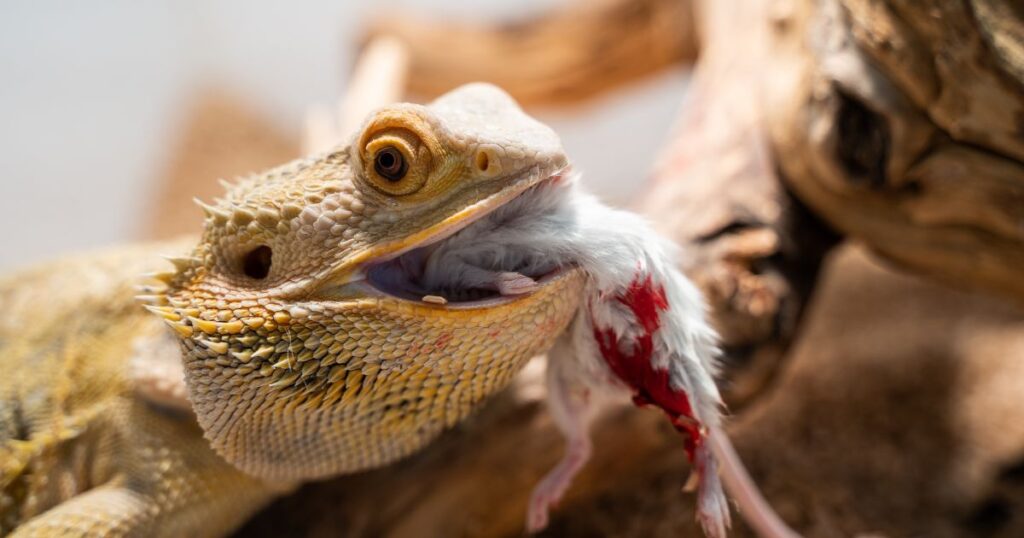
Conclusion
Feeding your bearded dragon might seem complicated, but once you understand their dietary needs and how often they should be fed, it becomes a lot easier. Whether you’re caring for a baby, juvenile, or adult bearded dragon, providing a balanced diet is key to their health and happiness.
Remember, every bearded dragon is unique, and their dietary needs can vary. Always monitor your dragon’s weight and adjust their diet as needed. And don’t forget to offer a variety of foods to keep their diet interesting. With the right care and nutrition, your bearded dragon can live a long, healthy, and happy life. So, here’s to many more adventures with your scaly friend!
Disclaimer: This guide is intended to provide general information on feeding bearded dragons. It is not a substitute for professional veterinary advice. Always consult with a qualified reptile vet for specific dietary advice for your bearded dragon.
If you want to learn more about bearded dragon care, check out the Bearded Dragon Care category. And don’t forget to check out my index page on Bearded Dragon Diet. Happy dragon parenting!
For those of you who are curious about other aspects of bearded dragon diet, you might find our previous posts Feeding baby bearded dragons and Feeding insects versus feeding vegetables interesting.
Frequently Asked Questions
How often and how much should I feed my bearded dragon?
The feeding frequency and quantity for your bearded dragon depend on their age. Baby bearded dragons should be fed 2-3 times a day, while adults should be fed once daily. They should be allowed to eat as many appropriately sized insects as they can in a 10-15 minute period.
What do you feed a beardie daily?
A bearded dragon’s daily diet should include a mix of insects, greens, and vegetables. The proportion of these food groups varies with the age of the bearded dragon. Younger dragons require more protein from insects, while adults need a diet rich in greens and vegetables.
How long can bearded dragons go without food?
Adult bearded dragons can go for up to two weeks without food under certain circumstances, such as brumation. However, this is not ideal, and regular feeding should be maintained. Baby and juvenile bearded dragons should not go without food for more than a day or two as they are growing and need regular nutrition.
How often do bearded dragons eat and poop?
Bearded dragons typically poop once a day, but this can vary depending on their diet and temperature of their environment. Younger dragons that eat more frequently may poop more than once a day.
Should bearded dragons be fed everyday?
Yes, bearded dragons should be fed every day. However, the type of food and the frequency of feeding will depend on their age. Baby and juvenile bearded dragons need to eat insects daily, while adults should be fed greens and vegetables daily with insects only a few times a week.
Can you overfeed a beardie?
Yes, it’s possible to overfeed a bearded dragon, especially with high-fat foods like mealworms. Overfeeding can lead to obesity and other health issues. It’s important to provide a balanced diet and monitor your dragon’s weight.
Can bearded dragons eat mealworms everyday?
Mealworms are high in fat and should not be the main staple of a bearded dragon’s diet. They can be offered occasionally, but other insects like crickets and dubia roaches are better for daily feeding.
Can bearded dragons eat superworms everyday?
Superworms, like mealworms, are high in fat and should not be fed to bearded dragons daily. They can be included in the diet occasionally for variety.
How many times a day should I hold my bearded dragon?
Handling your bearded dragon once or twice a day is usually sufficient. It’s important to give them time to rest and digest their food. Always wash your hands before and after handling your dragon to prevent the spread of germs.
How often do you bathe a bearded dragon?
Can bearded dragons eat bananas everyday?
Bananas should be fed to bearded dragons sparingly as they are high in sugar. They can be offered as a treat once in a while, but not as a daily part of their diet.
Can bearded dragons not eat for a day?
While adult bearded dragons can technically go a day without food, it’s not recommended. Regular feeding is important for their health and wellbeing. If your bearded dragon refuses to eat for more than a day or two, it could be a sign of illness and you should consult a vet.
What veggies can bearded dragons eat every day?
Bearded dragons can eat a variety of vegetables daily, including bell peppers, squash, and zucchini. Leafy greens like collard greens and dandelion greens should also be a regular part of their diet.
How often should I feed my adult bearded dragon insects?
Adult bearded dragons should be fed insects 2-3 times a week. The rest of their diet should consist of greens and vegetables.
Can bearded dragons eat too many greens?
While greens should make up a significant portion of an adult bearded dragon’s diet, it’s still possible to overfeed them. Offer a variety of greens and monitor your dragon’s weight and health.
How often should I feed my baby bearded dragon greens?
While the main part of a baby bearded dragon’s diet should be insects, greens should still be offered daily. They might not eat much of them at this age, but it’s good to get them used to eating greens.
Can bearded dragons eat fruit every day?
Fruit should only make up a small portion of a bearded dragon’s diet due to its high sugar content. It can be offered as a treat once or twice a week.
How many crickets should I feed my bearded dragon?
The number of crickets you should feed your bearded dragon depends on their age. Babies and juveniles should be allowed to eat as many crickets as they can in a 10-15 minute period. Adults should be fed crickets 2-3 times a week.
Can bearded dragons eat vegetables every day?
Yes, adult bearded dragons should be fed vegetables every day. They can also eat a variety of leafy greens. Babies and juveniles should also be offered vegetables, but they might not eat much of them.
How often should I change my bearded dragon’s water?
Bearded dragons should always have access to fresh water. It’s best to change the water daily to ensure it’s clean and safe for your dragon to drink.
